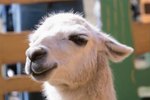
The llama (Lama glama) is a domesticated mammal that is a member of the same family as the camel (Camelidae). Although llamas share some physical traits with camels, especially body-wise, they lack the fat storage humps that are such a trademark of the latter. Llamas frequently are used as pack animals, and are known for their generally companionable temperaments.
About the Llama
Llamas have slender and elongated necks, and usually weigh around 250 pounds, indicates the National Geographic. As far as coat coloration goes, llamas appear in several varieties, with reddish-brown being particularly prevalent. Black, white and tan also all are common. Mating in llamas takes place once a year, with the season lasting from November all the way up into May. Mothers carry one "cria," or baby llama, at a time. The life expectancy for a llama is roughly 20 years, according to the Michigan State University College of Veterinary Medicine.
Diet of the Free Roaming Llama
Llamas are herbivorous animals that partake in grazing and browsing activities. Grass is a big part of a free-roaming llama's dietary intake. Out in the wild, llamas also frequently feed on forbs, lichens, tree foliage, native shrubs, and young and tender shoots.
Llama Diet in Captive Settings
Llamas generally live in captive settings, such as farms and zoos. In these types of environments, these camelids usually are fed grains, herbivore pellets and grass hay. Fiber is a very important element of the llama diet. Llamas also enjoy occasional treats. Some typical llama treats are fresh vegetables and fruits, such as broccoli, sweet potatoes, carrots and apples -- all sliced up into small and manageable bites. In domestic environments, llamas often consume similar foods as goats and sheep.
Llamas and Drinking Water
A llama's hydration is just as crucial as his feeding habits. A consistent supply of fresh and clean H20 is absolutely integral for keeping a llama in good health. In the wild, however, llamas usually are capable of going for long spells of time without drinking water, as they are able to acquire their necessary hydration through plant consumption.
References
Photo Credits
-
Thinkstock/Comstock/Getty Images




